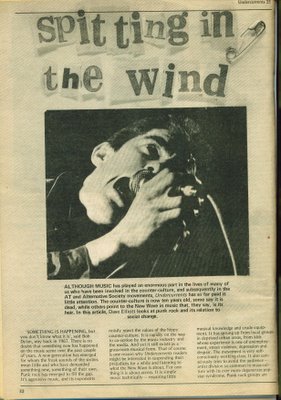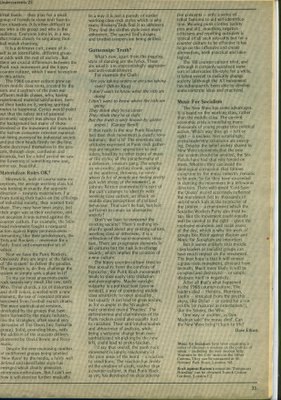Crass in Context 3 - seventies radical's view of punk
 This article is taken from a magazine called Undercurrents, Number 25, Dec 1977/ January 1978. I have scanned in pages from previous issue below.
This article is taken from a magazine called Undercurrents, Number 25, Dec 1977/ January 1978. I have scanned in pages from previous issue below.Undercurrents ran from 1974 to 1981. It developed and continued on from the more down to earth and practical political ( but witha few ley lines thrown in) aspects of the 66 to 74 counter culture underground. The underground mag OZ , for example, ran stories on what was then called alternative technology and what are now Green issues. If I had not thrown out/ lost the old issues of OZ I had, would scan in to illustrate.
If what became UK punk can be traced back to and was a continuation of the more over the top/ situationist/ surrealist/ dadaist/ nihilist aspects of that counterculture, then Undercurrents represents an alternative trajectory, one which led to today's Greens and to the eighties/ nineties/ ongoing radical protest movements and campaigns.
Windmills and psychedelic dreams
Part of the post-sixties counterculture involved setting up communes and organic farms and building windmills - way back in 1972 a big house near here was taken over by / as a commune - Laurieston Hall. Still going, but now as a housing co-op. See http://www.diggersanddreamers.org.uk/record_detail.php?eight=lauriest for details.
I assume Dial House came out of that era and that down to earth seventies version of sixties radicalism.
In 1977 I remember going to a party in a 'hippy' house in Galloway
and looking through their record collection. It was huge, but kind of tailed off
 after about 1972- the most recenty record being Ziggy Stardust by Bowie. It was as if change and growth had stopped then. In 1985 I remember playing some Sex Pistiols to Charley Barley - a Stonehenge/Glastonbury/ traveller and ex- London squatter.
after about 1972- the most recenty record being Ziggy Stardust by Bowie. It was as if change and growth had stopped then. In 1985 I remember playing some Sex Pistiols to Charley Barley - a Stonehenge/Glastonbury/ traveller and ex- London squatter.He was impressed "Wow , what is this amazing shit!" was his comment.
"Uh, punk" I replied. His ex-partner Willow ( mentioned in C.J. Stone's "Last of the Hippies " book : Faber and Faber: 1999 - CJ was a Guardian columnist for a while) told me when she first saw some punks at Stonehenge she though they were aliens...
Credit to Penny Rimbaud and Crass - he/ they engaged with punk. But did he/ they do so from a similar point of view and understanding of what punk was as expressed by Dave Elliot here/ in Undercurrents? Which shopuld be readable if you click on text.
Quote :
It [punk] has sprung up from local groups in deprived urban areas, from kids whose experience is one of unemployment, street violence, depression and despair. The movement is very self-consciously working -class...
Yeah, sure - Malcolm Mclaren and Vivienne Westwood and Jamie Reid and Bernie Rhodes were all deprived working class kids. Of course they fucking weren't (do they owe us an explanation?- course they fucking do!).
As Jon Savage suggested and as Tom Vague has proved (despite Stewart Home), punk was a a straightforward continuation of the "be realistic: demand the impossible" surrealist/ dadaist/ nihilist/ situationist revolutionary tradition and culture.
I could be right, I could be wrong. I will keep posting up bits and pieces like the above - read 'em, look at 'em and work it out for yourself.

0 Comments:
Post a Comment
<< Home